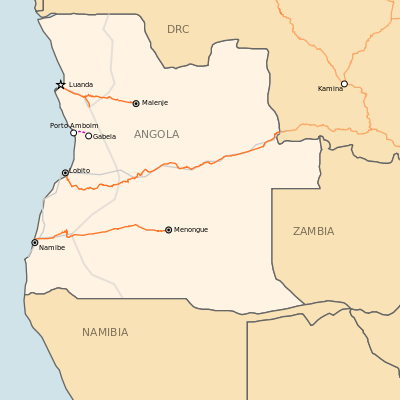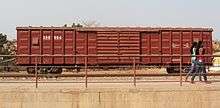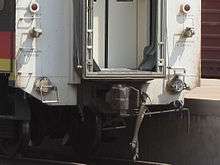Rail transport in Angola

1067mm gauge tracks, 610mm gauge tracks
Rail transport in Angola consists of three separate Cape gauge lines that do not connect: the northern Luanda Railway, the central Benguela Railway, and the southern Moçâmedes Railway (southern). The lines each connect the Atlantic coast to the interior of the country. A fourth system once linked Gunza and Gabala but is no longer operational.
History
Railway construction began in Angola in 1887, while the country was a colony of Portugal. The Luanda Railway opened in 1889, the Moçâmedes Railway opened in 1910, and the Benguela Railway opened in 1912. The railways continued to be extended inland until 1961, when the Moçâmedes Railway reached Menongue.[1][2] After Angola attained its independence from Portugal in 1975, the Angolan Civil War broke out and lasted until 2002. The prolonged fighting resulted in the destruction of most of Angola's railway infrastructure. The rebels blew up bridges, tore up track, and sabotaged the right of way with land mines to prevent the railway from being restored.[3]
When the fighting ended, the Angolan government sought to restore service on the railways. Contracts were awarded to the state-owned China Railway Construction Corporation Limited to rebuild the Luanda Railway and the Benguela Railway. A privately-owned Chinese mining company rebuilt the Moçâmedes Railway.[4] All three colonial-era Cape gauge lines had been rebuilt by 2015.
Statistics
- total: 2,761 km
- narrow gauge: mainly 2,638 km of 1,067 mm (3 ft 6 in) (Cape gauge)
- there is also 123 km of 600 mm (1 ft 11 5⁄8 in) gauge (2002)
Links with neighbouring countries
The Benguela Railway connects to the Katanga Railway at the border with the Democratic Republic of the Congo. The first train reached the border town of Luau in August 2013.[5] However, the Congolese railways are in a deteriorated state and no through services are available as of 2015. Passengers and freight must use buses and trucks to reach destinations in Congo.
Towns served by rail
Specifications
Rolling stock


Locomotives
| Type | Manufacturer | Notes | Source |
|---|---|---|---|
| CKD8F locomotive | CNR Dalian, Dalian, China | [6] | |
| SDD6A locomotive | CSR | [7] | |
| C30ACi locomotive | GE Transportation | [8] | |
| CSR passenger coach | CSR | [9] | |
| CSR box wagon | CSR | [10] | |
| CSR open wagon | CSR | [11] | |
| CSR tank wagon | CSR | [12] | |
Railways rehabilitation and modernization programme
After the end of the civil war, the government could start to plan both the rehabilitation of the "network" inherited from the colonial power and largely destroyed by the civil war, and its extension by building new lines, interconnecting the existing lines and connecting with all neighbouring countries. If and when completed, this would result in a grid of three east-west lines and three north-south lines, linking all 18 provinces to the railway network. This plan is known also by the name Ango-Ferro. [13][14]
New institutional framework
Related to the program to rehabilitate the network inherited from colonial times and the project to build new lines, the institutional framework of railway operations was changed in a series of presidential decrees in 2010.[15]
As public administration to oversee, regulate, certify, and licence railway companies, infrastructure and rolling stock, the Instituto Nacional dos Caminhos de Ferro de Angola (INCFA - National Institute for Railways in Angola) was created out of the Directorate of Terrestrial Transport within the transport ministry.
All railway infrastructure, lines, tracks, stations, maintenance facilities etc. were declared to be in the public domain controlled by the state. The three railway companies became Empresa publica (E.P.), government operated enterprises reporting to the transport ministry. The infrastructure was separated from the operation of the trains, opening up the possibility that private companies could run trains in the future.[16]
Technical integration with SADC countries

Twin air brake pipes with taps.
Most railways in the SADC (Southern African Development Community) countries run on Cape gauge 1,067 mm (3 ft 6 in), which facilitates the planned integration of the planned Angola railway network with the neighboring countries without forcing trans-shipments at border crossings. This involved also the technical interoperability of rolling stock, and that led to the adoption of the AAR coupler, which is in use in South Africa for a long time already.
The Southern African Railways Association (SARA) is a body for this standardisation. The current three Angolan railway companies are members of SARA.
Planned new lines
The plan involves eight new lines:[13] [17]
Caminho de Ferro do Congo
This line would start at downtown Luanda and reach the Congo mouth at Soyo and then Cabinda via a wide Eastward curve passing via Caxito, Ucua, Quibaxe, Dange, Uíge, Songo, Lucunga, Madimba, Zaire, M'banza-Kongo, Quiende, Lufico to Soyo. The line then shall cross the Congo river between Soyo and Munanda, cross for about 40 km the RDC to enter Angolan territory again in Cabinda province at Imã to reach Cabinda city, and continue from there via Landana, Buco Zau, Belize, Cabinda to Miconje, where it is to connect with the rail network of Congo Brazzaville. This line would total about 950 kilometers. A feasibility study is being undertaken now. This line was already discussedn in 2008[18]
In an earlier document from the transport ministry, there was a border crossing to RDC planned further up-stream, where the Congo river is not so wide and where the RDC/Angola border moves away from the river bank, i.e. at Noqui (Angola) and Matadi (RDC).[14]
Link with Zambia
This would branch off the Benguela railway at Luacano and go south-east via Lago Dilolo, Sapito, Moxico, Samucal, Cazombo, Camanga, and Calunda to Macongo, where it would link to the line serving a new mine at Lumwana in Zambia. This line would be about 306 km long. A feasibility study is pending.
Western link to Namibia
This link of probably 343 km would start from the CFM at Cuvango and to south via Cassai, Xamutete, Cuvelai, Mupa, Evale, Ondjiva to Namacunde, where it would connect with the Namibian line Tsumeb to Oshikango. This link had also been discussed during a state visit of the Angolan president in Windhoek in October 2007.[19] A feasibility study is pending.
Extension of the Luanda railway to Saurimo
The Luanda railway shall be extended beyond Malanje by 527 km via Caculama, Xá Muteba, Capenda, Camulemba, Cacolo, to Saurimo in Lunda Sul province. There it would link with the Eastern north-south line, specified in the next section. A feasibility study is pending.
Transversal do Leste (Eastern transversal)
This new line would extend 1353 km from North to South, beginning at the border with R.D. Congo at Chitato, then via Luachimo, Dundo, Camissombo, Lucapa to Saurimo where it connects with the planned new endpoint of the Luanda railway, further via Camanogue to Luena where it connects to the Benguela railway, further via Lucusse, Cassamba, Cangombe, and Lupire to Cuito Cuanavale where it connects with the planned new endpoint of the Moçâmedes railway (CFM), and then via Mavinga to Mucusso on the Okavango river, where it connects to the Tsumeb - Caprivi line in Namibia. A feasibility study is pending.
Extension of the Moçamedes railway to Cuito Cuanavale
This would extend the existing line by about 180 km beyond the current end point Menongue via Longa to Cuito Cuanavale where it connects with the Transversal do Leste. A feasibility study is pending.
Transversal Norte-Sul (North-South transversal)
This central north-south line of planned 896 km starts at Uíge, from the planned Congo railway going south from there via Negage, Camabatela, Luinga, and Calandula to Malanje, the current end point of the Luanda railway, from there further south via Cangandala, Mussende, Calussinga, Andulo, and Cuhinga to Kuito, where it connects to the existing Benguela railway, and from there via Chitambo and Cuvango, where it connects with the existing Moçâmedes railway and the planned new line to Oshikango in Namibia. A feasibility study is pending.
Interconnection of the three historic lines
This new line of 589 km would start as an extension of the existing Dondo branch of the Luanda railway, and go south via Quibala and Waco Kungo to Huambo, connecting there to the existing Benguala railway, continuing further south via Cuima to Cuvango, where it connects — like the Transversal Norte-Sul to the existing Moçâmedes railway and the planned new line to Oshikango in Namibia. A feasibility study is pending.
This line creates a direct rail link from the capital Luanda to Angola's second city Huambo and to Namibia.
Implementation
Speaking to the press in July 2012, on the occasion of the coming opening of the reconstructed CFB line to Luena, the director of the INCFA, Júlio Bango Joaquim, said that the construction of new lines would begin as soon as the three historic lines are operational in their full length. He placed the direct link to Zambia, bypassing the DR Congo, on top of the priority list, the link to Namibia coming next.[20]
See also
References
- ↑ The Geographical Digest (1963 ed.). George Philip and Son. 1963. p. 69.
The 95 km. extension of the Mocamedes Railway from Cuchi to Serpa Pinto was inaugurated in December 1961. The railway, which uses the gauge of 3' 6", now has a total length of 754 km.
- ↑ Foreign agricultural economic report: Angola. U.S. Department of Agriculture, Economic Research Service. 1961. p. 9.
The Mocamedes Railway extends only as far as Menongue (former Serpa Pinto), but could be extended to Zambia.
- ↑ Maykuth, Andrew (October 16, 1997). "Victim Of War May Yet Chug Again". Philadelphia Inquirer.
- ↑ "China Construction Hyway delivers Moçâmedes railway reconstruction project in Angola". Macauhub. September 14, 2015.
- ↑ "FIRST CFB TRAIN REACHES LUAU". Railways Africa. 20 August 2013. Retrieved 25 August 2013.
- ↑ "CNR Dalian locomotives arrive in Angola". Railway Gazette. 13 August 2012.
ANGOLA: CNR Dalian has delivered the first five of 15 diesel locomotives ordered last year. Rated at 1715 kW, the 1067 mm gauge CKD8F locomotives have a top speed of 160 km/h and feature air-conditioned cabs and dust filters for use in the desert environment.
- ↑ "SDD6A diesel locomotive".
- ↑ "CFM takes delivery of GE locomotives". Railway Gazette. 2 February 2014.
- ↑ "Passenger Coach for Angola".
- ↑ "Box Wagon for Angola".
- ↑ "Open Wagon for Angola".
- ↑ "Tank Wagon for Angola".
- 1 2 "Projectos".
- 1 2 Presentation of Ing. José Luyindula of GCL on the project Ango-Ferro
- ↑ Documents on the reform of Angola railway institutional framework
- ↑ "Government wants private operators in railway sector". Railways Africa. Retrieved 2010-11-27.
- ↑ Lourenço, Manuel João (20 June 2011). "Projecto de reabilitação e modernização dos caminhos de ferro de Angola" [Project to rehabilitate and modernize the Angolan railways] (in Portuguese). Instituto Nacional dos Caminhos de Ferro de Angola (INCFA)/Angolan transport ministry.
- ↑ Railways Africa - NORTHERN ANGOLAN RAIL LINK-UP
- ↑ Railways Africa - ANGOLA-NAMIBIA LINK
- ↑ "Carruagens do CFB avançam para Leste" [CFB wagons advance towards the East]. Jornal de Angola (in Portuguese). Edições Novembro. 31 July 2012. Retrieved 1 August 2012.
External links
- INCFA website
- Section on railways at the Portal dos Transportes of the transport ministry
- Transport ministry of Angola
- UNJLC Map